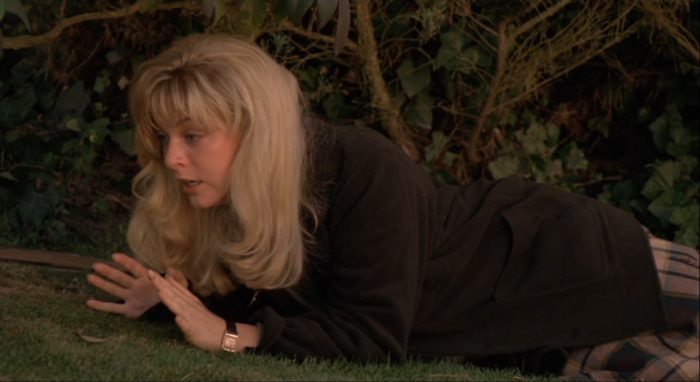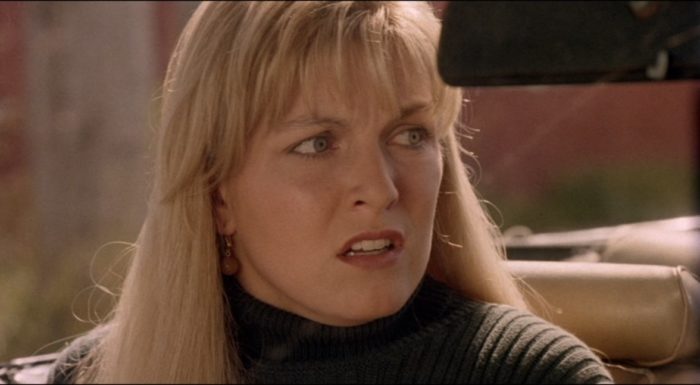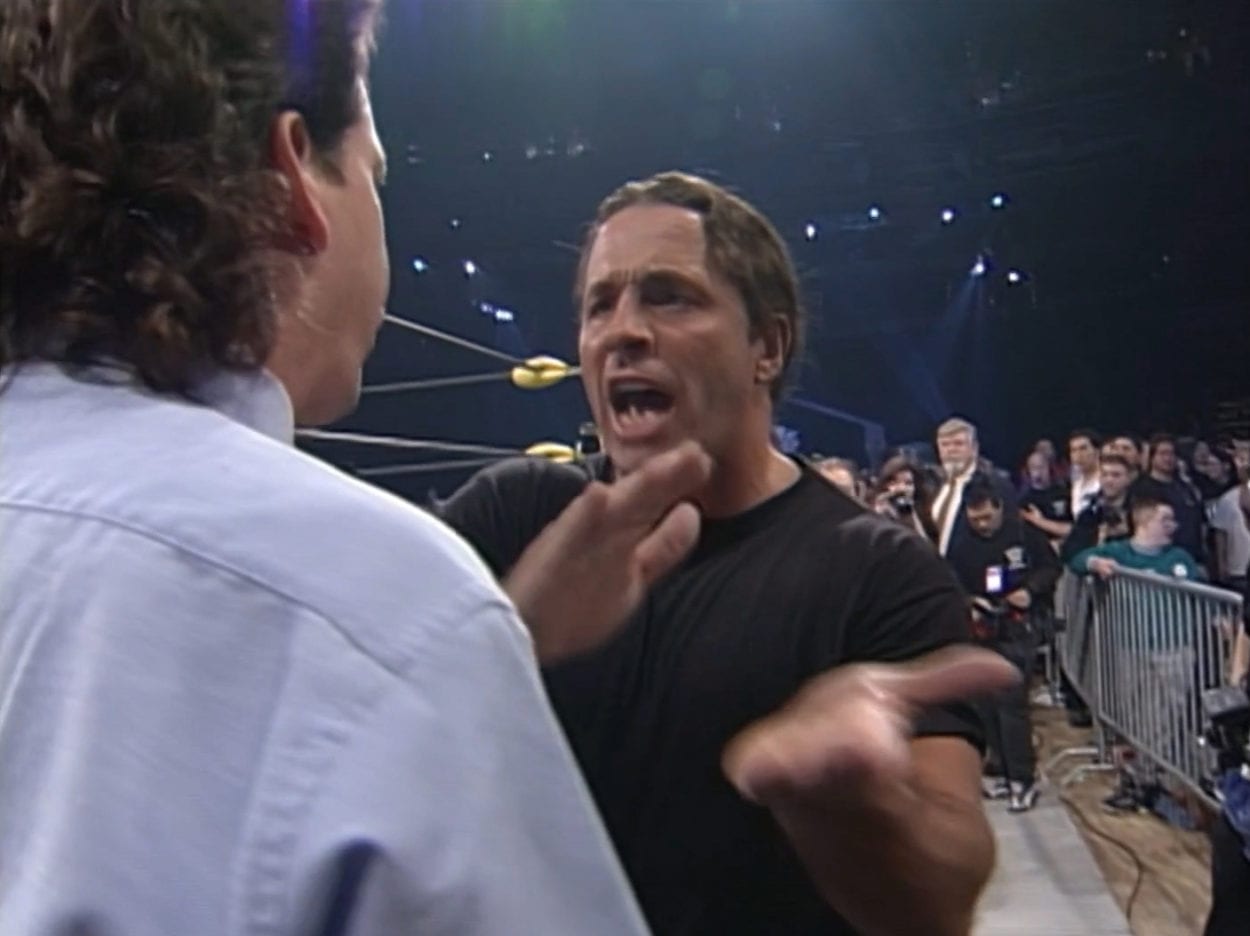It feels funny to write about Fire Walk With Me when so much has already been said about the film and about Twin Peaks in general. When I was working on this article the other night, I laughed out loud. I thought to myself, “Are we still writing about this show?” There are so many interpretations and theories; some are more plausible than others, but none hold the certainty of truth.
When I first joined 25YL in 2018, it was because of Twin Peaks, but so much was being written about it at the time, I didn’t feel like there was room for me to say anything about it. Everyone else was much more familiar with the series, the episodes, the characters, the dialogue, the actors, and the imagery—and I was just someone who enjoyed the show. I liked the experience of it, especially the visceral sense of mystery that permeates so much of it. I was never really concerned with creating elaborate theories or coming up with answers. Mostly, I just liked spending time in the strange Washington town.
Even now, I feel awkward and almost incapable of writing about Twin Peaks, mostly because I feel ill equipped in comparison to the people who have already written about it. Be that as it may, I still want to offer my unfiltered perspective of the piece of the Twin Peaks universe that emotionally impacted me the most: David Lynch’s 1992 film, Fire Walk With Me. However, unlike most Twin Peaks fans, I didn’t actually see the film until after I watched The Return, so you can imagine my confusion when I saw scenes that were obviously filmed with the same cast in the early 1990s that I was unable to place. Eventually, I sat down and watched it, and was utterly blown away. I was not expecting it to be as powerful as it was, nor was I expecting to see so much of myself in the story, particularly in Laura (Sheryl Lee). After I saw it, it changed my feelings about The Return, and not necessarily for the better. Regardless, for me, the two are inextricably bound up in one another, as you will see.

The existence of Fire Walk With Me is pretty odd. The pilot episode of Twin Peaks begins with Laura’s death. The story begins with the discovery of her body, and from then on, we only see glimpses of her, either on film, as other characters (Maddy Ferguson, Carrie Page), or in the red room; she’s always just out of reach. After Leland was eventually identified as her killer, the show became sort of aimless. The mystery of Laura’s killer was the driving engine of the show, and once that mystery was gone, there really wasn’t enough momentum to keep me interested. I know this is not a novel experience, but I feel the need to say it, nonetheless.
About a year after The Return concluded, when I watched Fire Walk With Me, I wondered: Why did Lynch decide to tell this story? Was it just to see Laura alive? To watch her suffer and then get brutally murdered? The film’s existence is certainly strange, but for me, its power is indisputable. The Return, on the other hand, does not feel like it needs to exist. I thoroughly enjoy parts of it, but in terms of its emotional impact, it pales in comparison to Fire Walk With Me. I can see myself so clearly in this film. It’s like I enter into it, full-bodied, and the world disappears.

When Laura enters her house in search of BOB, the house has changed. Every room is riddled with fear and anxiety; the air seems to shake. The sound of the whirring fan is like an ominous, palpitating heart. After Laura discovers BOB in her room, she runs outside and hides beneath some bushes. Her father, Leland (Ray Wise), walks out of the house, and she begins to sob; she almost dry heaves the words: “Oh my god, oh my god, no no no no. It’s not him, it’s not, it’s not him.”
I can never get over how much I feel for Laura in this scene; she’s become a stranger in her own home, so she runs outside and hides beneath a bush like a wounded animal. This scene struck a nerve with me from the first moment I saw it, because I felt this way many, many times in my life. I spent a great deal of my childhood and adolescence in a prolonged state of panic. It became so normal that it took me a few decades to even recognize that I’d been perpetually afraid of the world and most people in it. Much of this fear revolved around my mother, who was a severe alcoholic. When she drank, her personality radically transformed, and she essentially became BOB. Usually, the heavy drinking wouldn’t start until after I went to sleep. Then, I would be startled awake by loud music and the laughter of unknown guests; sometimes there were slammed doors, arguments, and screaming. It was like waking up into a nightmare, but whenever I went back to sleep and woke up in the morning, it was like none of it happened. My life was often like that: marked by extremes and permeated with an unreal quality. My memories often didn’t add up, and I never quite knew what was real.

The dinner scene in Fire Walk With Me is also viscerally disturbing. Leland interrogates Laura,Sarah (Grace Zabriske) fumes, and Laura’s mouth hangs open in shock, as if frozen in a silent scream. When I sit down at the table with them, I feel as if I will weep, or like I should weep, but I can’t; it’s like I’m constipated. The feelings are there, welling up, but somehow, in this frigid, toxic house, they simply won’t come out. Sometimes my own home felt this way.
I remember many dinners where I swallowed food without chewing, hid pieces of food in napkins, and moved food around on my plate to make it look like I had eaten, just so I could leave the table sooner. As I answered the obligatory questions about my day, I often stared into my food in an effort to avoid my discomfort. But it never worked.
Leland’s drive with Laura is easily my favorite scene in this film, even though it is one of the most overwhelming moments. After the pair are accosted by MIKE (Al Strobel), Leland drives the car into Mo’s Mechanics. Leland yells at the attendants and quickly asks Laura if she’s alright. Laura fires back, “Dad, are you alright?” In this moment, Laura is a parentified child. She has to ask Leland if he is okay, even though she is the child who is obviously in need of care and reassurance. But Leland is not capable of this. He is lost in his own guilt-ridden memories and is unable to hear Laura’s voice.

The first time I watched this scene, I knew I was Laura. I saw Laura attempting to take care of her father, someone she could not rely on or trust, even though she was clearly in an enormous amount of pain. It was like huge parts of my childhood and adolescence were encapsulated in a single scene.
I spent a great deal of time with drunk and/or psychologically unstable adults, so I unconsciously stepped into the role that was most needed: the mature adult. Even as a kindergartner, I felt deeply responsible for everyone around me. I was compelled to manage their moods, their happiness, and even their sobriety. But every time I had to be the adult in the situation, it took a toll. Over time, it felt like more and more of me withered away.
What Return?
In the story of Twin Peaks, Laura was a girl who was violated and murdered by her own father. But she is also a kind of metaphysical image: the golden orb (head) of goodness, or the goose that kept laying golden eggs until network television executives stepped in and stomped all over the eggs, leaving behind a glistening pile of broken shells. This was Laura’s real death: the cessation of her ability to birth mysteries, to give gold, to do what she was meant to do. This death tainted her memory, the town, and the show itself. Laura’s last moments on earth were given to us to understand the full horror of what we were asking for, which is continued on in the darkness of The Return.
I think of Laura now, withering away and burning out, and I wonder how many kids are out there right now, dying in plain sight. Laura’s story is my story, Andrew’s story, everyone’s story; we see our pain in her; she is like a healing vessel we pour ourselves into. So, in a way, she does live on, in us and in the film, which is the most alive we will ever see her.
Fire Walk With Me is a tale of pain, anguish, and incest. It is a story about a violation that leads a young girl to a kind of suicide; she is in so much pain she believes there is only one way out: nonexistence. But that isn’t true. There is always another way, another wish, something hidden behind the desire for death: the yearning for change, a new existence, a better life, a better world. Laura’s life would’ve been better if the people around her had paid attention and been able to put the fire out before it blazed out of control and went beyond the point of no return. There was no return, not really, not of Laura and not of Twin Peaks. We were left only with that final, terrible scream. The lights went out and all was lost, yet again.
It pains me to say this, but we can never bring Laura or Twin Peaks back. What is lost is lost, and no amount of parallel universe hopping will ever change that. As viewers, we yearned and craved and demanded, and in return (and in The Return) were given even more images of meaningless violence. The Return was a dark, beautiful offering. But it feels so devoid of life because Laura, mother of all mysteries, was already gone.



